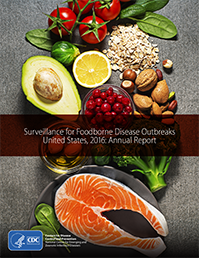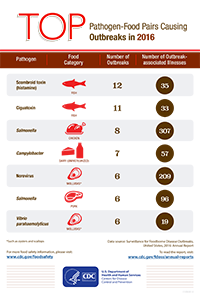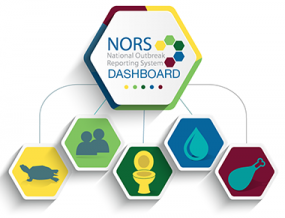Highlights from the 2016 Surveillance Report
When two or more people become ill from consuming the same contaminated food or drink, the event is called a foodborne disease outbreak. Outbreaks provide important insights into how pathogens (germs, chemicals, or toxins) are spread, which food and pathogen combinations make people sick, and how to prevent food poisoning. Each year, CDC summarizes foodborne disease outbreak data in an annual surveillance report and makes it available to the public through the NORS Dashboard.
Main Findings
In 2016, 839 foodborne disease outbreaks were reported, resulting in 14,259 illnesses, 875 hospitalizations, 17 deaths, and 18 food recalls.
- Single food categories associated with the most outbreak illnesses:
- Mollusks, such as oysters and scallops (529 illnesses)
- Pork (438 illnesses)
- Grains and beans (383 illnesses)
- Single food categories associated with the most outbreaks:
- Fish (26 outbreaks)
- Mollusks (21 outbreaks)
- Dairy (19 outbreaks)
- Restaurants were the most commonly reported location where food was prepared (459 outbreaks, 61% of outbreaks reporting a single location of preparation), specifically restaurants with sit-down dining (363, 48% of outbreaks).
- There were 39 multistate outbreaks, including the following types of foods linked to them:
- Sprouts (4 outbreaks)
- Beef (3 outbreaks)
- Seeded vegetables, such as cucumbers (3 outbreaks)
- Fruit (3 outbreaks)
- Nuts and seeds (3 outbreaks)
- Chicken (2 outbreaks)
- Vegetable row crops, such as leafy greens (2 outbreaks)
Other Highlights
A single, confirmed pathogen caused 399 outbreaks. The most commonly reported were:
- Norovirus (145 outbreaks, 36% of the outbreaks)
- Salmonella (132 outbreaks, 33% of the outbreaks)
A single, confirmed pathogen caused 9,123 outbreak-related illnesses, 812 hospitalizations, and 15 deaths. The most common causes of outbreak-related illnesses were:
- Norovirus (3,794 illnesses, 42% of the illnesses)
- Salmonella (3,047 illnesses, 33% of the illnesses)
- Clostridium perfringens (512 illnesses, 6% of the illnesses)
The pathogens that caused the most outbreak-related hospitalizations were:
- Salmonella (456 hospitalizations, 56% of outbreak-related hospitalizations)
- Hepatitis A virus (141 hospitalizations, 17% of outbreak-related hospitalizations)
- Shiga toxin-producing Escherichia coli (98 hospitalizations, 12% of outbreak-related hospitalizations)
The pathogens that caused outbreak-related deaths were:
- Listeria monocytogenes (3 deaths)
- Salmonella (3 deaths)
- Shiga toxin-producing Escherichia coli (3 deaths)
- Clostridium botulinum (2 deaths)
- Hepatitis A virus (2 deaths)
- Clostridium perfringens (1 death)
- Staphylococcus aureus (1 death)
- Vibrio cholera (1 death)
Investigators were able to identify the food that made people ill in 38% of the outbreaks (323 outbreaks). The food could be placed into a single category, out of 24 possible categories, in slightly more than half of those outbreaks (180). The most commonly implicated food categories were:
- Fish (26 outbreaks, 14% of the outbreaks)
- Mollusks (21 outbreaks, 12% of the outbreaks)
- Dairy (19 outbreaks, 11% of the outbreaks): all involved raw (unpasteurized) products
- Pork (18 outbreaks, 10% of the outbreaks)
Outbreaks in which the food could be classified into a category resulted in 3,776 illnesses. Outbreak-associated illnesses were most commonly from:
- Mollusks (529 illnesses, 14% of the illnesses)
- Pork (438 illnesses, 12% of the illnesses)
- Grains and beans (383 illnesses, 10% of the illnesses)
- Chicken (356 illnesses, 9% of the illnesses)
Knowing which pathogen and food combinations make people sick is important for preventing outbreaks. The confirmed pathogen-food pairs responsible for the most outbreaks were:
- Scombroid toxin (histamine poisoning) in fish (12 outbreaks)
- Ciguatoxin in fish (11 outbreaks)
- Salmonella in chicken (8 outbreaks)
The confirmed pathogen-food pairs responsible for the most illnesses, hospitalizations, and deaths were:
- Illnesses
- Bacillus cereus in grains and beans (348 illnesses)
- Salmonella in chicken (307 illnesses)
- Hepatitis A virus in mollusks (281 illnesses)
- Hospitalizations
- Hepatitis A virus in mollusks (71 hospitalizations)
- Hepatitis A virus in fruits (57 hospitalizations)
- Salmonella in beef (44 hospitalizations)
- Deaths
- Hepatitis A virus in mollusks (2 deaths)
- Listeria monocytogenes in dairy (2 deaths): all involved raw (unpasteurized) products
*The term “pathogens” as used here includes other agents, such as toxins.
Among the 751 outbreaks and 12,622 illnesses with a reported single location where food was prepared, 459 outbreaks (61%) and 5,353 associated illnesses (42%) were attributed to foods prepared in a restaurant.
Among these outbreaks, sit-down dining restaurants were most commonly reported as the location where food was prepared (363 outbreaks, 48% of the outbreaks).
Product recalls occurred in 18 outbreaks:
- Oysters (3 outbreaks)
- Beef (2 outbreaks)
- Raw milk (2 outbreaks)
- Alfalfa sprouts (1 outbreak)
- Cheese (1 outbreak)
- Cilantro (1 outbreak)
- Cucumbers (1 outbreak)
- Frozen scallops (1 outbreak)
- Frozen strawberries (1 outbreak)
- Hazelnuts (1 outbreak)
- Masa dough (1 outbreak)
- Pistachios (1 outbreak)
- Seaweed and sea asparagus (1 outbreak)
- Shell eggs (1 outbreak)
In 2016, there were 39 multistate outbreaks (5% of all reported outbreaks), resulting in 1,055 illnesses (7% of illnesses), 283 hospitalizations (32% of hospitalizations), and 8 deaths (47% of deaths).
Pathogens responsible for multistate outbreaks:
- Salmonella (28 outbreaks)
- Shiga toxin-producing Escherichia coli (7 outbreaks)
- Listeria (2 outbreaks)
- Hepatitis A virus (1 outbreak)
- Norovirus (1 outbreak)
Foods implicated or suspected in multistate outbreaks of Salmonella:
- Chicken (1 confirmed, 1 suspected; 2 outbreaks total)
- Cucumber (2 outbreaks)
- Alfalfa sprouts (suspected; 1 outbreak)
- Avocado (suspected; 1 outbreak)
- Bean sprouts (suspected; 1 outbreak)
- Cantaloupe (1 outbreak)
- Eggs (1 outbreak)
- Ground beef (1 outbreak)
- Hazelnuts (1 outbreak)
- Mung bean sprouts (suspected; 1 outbreak)
- Nuts (1 outbreak)
- Onion (suspected; 1 outbreak)
- Peppers (1 outbreak)
- Pistachios (1 outbreak)
- Pork (suspected; 1 outbreak)
- Prepackaged leafy greens (1 outbreak)
- Salad mix (1 outbreak)
A food was not identified for nine multistate outbreaks caused by Salmonella.
Foods implicated or suspected in multistate outbreaks of Shiga toxin-producing Escherichia coli:
- Beef (2 outbreaks) (serogroup O157)
- Alfalfa sprouts (1 outbreak) (serogroup O157)
- Iceberg lettuce (suspected; 1 outbreak) (serogroup O157)
A food was not identified for three multistate outbreaks caused by Shiga toxin-producing Escherichia coli.
Food implicated in a multistate outbreak of Listeria:
- Raw (unpasteurized) soft cheese (1 outbreak)
A food was not identified for one multistate outbreak caused by Listeria.
Food implicated in a multistate outbreak of hepatitis A virus:
- Strawberries (1 outbreak)
A food was not identified for one multistate outbreak caused by norovirus.
Nine multistate outbreaks investigated in 2016 are not included in the 2016 tally because the first outbreak-associated illness occurred before 2016. Four were caused by Salmonella; the implicated foods were chia seed powder (first illness in 2014), alfalfa seeds and sprouts (first illness in 2015), cucumber (first illness in 2015), and moringa leaf powder (first illness in 2015). Three outbreaks were caused by Listeria. The implicated food in one Listeria outbreak was prepackaged lettuce (first illness in 2015). Hummus (first illness is 2013) and smoked fish (first illness in 2014) were suspected sources in two Listeria outbreaks. Lastly, two outbreaks were caused by Shiga toxin-producing Escherichia coli. Flour was the confirmed food implicated in one outbreak (first illness in 2015) and pizza dough mix was the suspected food implicated in the other (first illness in 2015).



